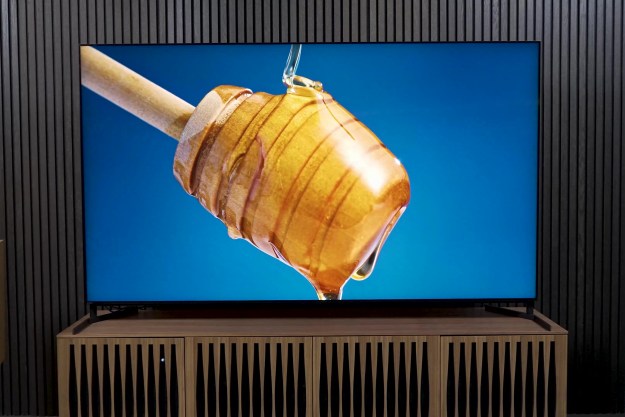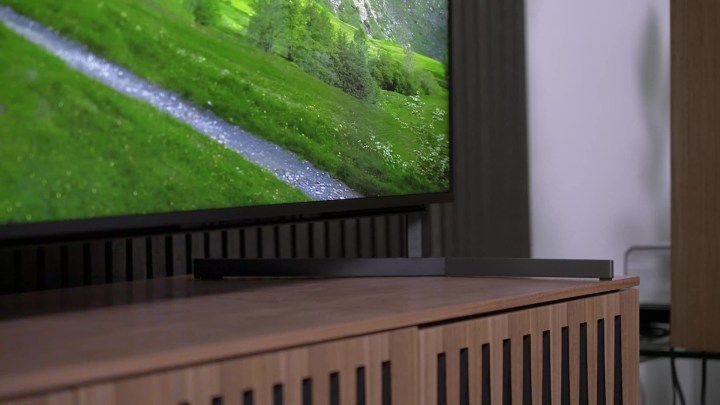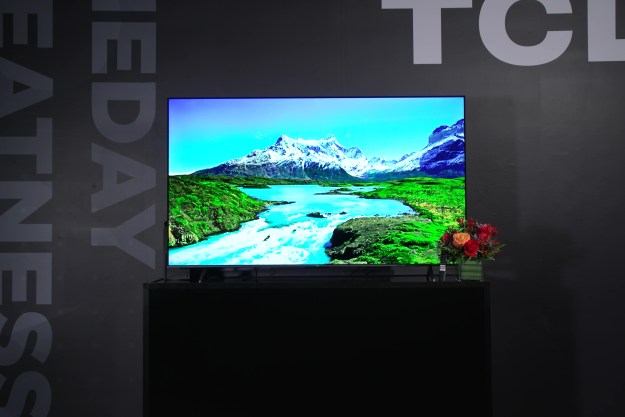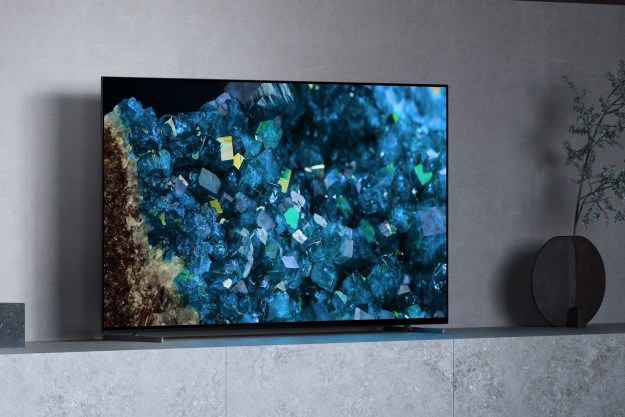
“The Sony Bravia X95L mini-LED TV is the best LCD TV I've ever reviewed -- but it may not be right for everyone.”
- Brilliant contrast
- Excellent color accuracy
- Smooth motion
- Minimal blooming and halo
- Excellent gaming features/picture quality
- Quirks with picture quality with some streaming apps
Typically, one is discouraged from giving away too much in the first few sentences of a product review, but I have to break the rules for this one.
The Sony X95L is the best LCD TV I’ve ever tested. That’s not hyperbole. This is it. This is the one. This is the way, as the Mandalorian would say.
However, just because I say this is the best LCD TV I’ve ever tested does not mean that it is necessarily the best TV for you to buy, even if cost is no object. The how, the why, and the what behind my claim are vital to understanding whether or not the X95L might be the best TV for your needs. So, if I may be so bold as to ask, please read on to find out what makes the Sony X95L such a remarkable TV, and together I hope we’ll arrive at a conclusion as to whether it might be the right TV for you.
Video review
Mini-LED mini explainer
Let’s start with a mini-LED primer, which you can skip if you think you know everything there is to know about mini-LED TVs — though what I’m about to say might surprise you.
All LCD TVs require a backlight. If we travel back in time a bit, we’ll see the first LCD TVs used cold cathode fluorescent bulbs, then moved to LEDs – at which point we stopped calling these LCD TVs and just LED TVs for short. Today, LCD TV backlighting technology has evolved toward using what we call mini-LEDs.
Mini-LEDs are much smaller than regular LED backlights. That means Sony (or whomever) can cram way more of them in the same amount of space, and that also means those lights can be gathered into more and smaller local dimming zones, where the mini-LEDs can be brightened and dimmed according to what happens on the screen. That’s a desirable point of technology because, in theory, the more local dimming zones you have, the more control you would have over the contrast on the screen, and the less blooming you would have around bright objects on dark backgrounds.
Just because a TV has mini-LED backlighting doesn’t necessarily mean it is going to be superior in picture quality to a standard LED TV.
However, as we’ve recently learned, just because a TV has mini-LED backlighting doesn’t necessarily mean it is going to be superior in picture quality to a standard LED TV. The Sony X90L is a great example of a TV with standard LED backlighting that outperforms comparably priced mini-LED TVs from competing brands.
It is also true that having more dimming zones doesn’t necessarily mean the TV’s picture quality is going to be better. Again, the Sony X90L is a great example of a TV that has far fewer dimming zones than similarly priced rivals, yet still looks outstanding.
I mention all of that because while the X95L is a mini-LED TV and it does have a respectable number of dimming zones, it probably does not have as many as, say, the TCL QM8 mini-LED TV. I say probably because despite trying, I’ve been unable to count the number of zones on this TV. It’s simply too hard for me to do using the conventional method of watching a tiny white box crawling across the screen, which brings me nicely to my next point.
Contrast balancing act
Having a glut of backlight dimming zones is not an advantage unless the TV also has a processor powerful enough to handle all of those zones. Specifically, the TV needs a really good local dimming algorithm to make sure all those zones dim and brighten quickly and precisely. Somewhat ironically, if any TV brand has the chops to build a super-advanced local dimming algorithm, it’s Sony. But that wasn’t Sony’s goal here. Instead, Sony sought to strike a balance between contrast — which admittedly is the most noticeable aspect of picture quality — and all of the other elements of picture quality.

And, folks, Sony did it. Now, I’m going to save most of the comparisons that illustrate this for the upcoming X95L-versus-TCL QM8 comparison. But the takeaway is that the X95L does the right amount of the right stuff to yield absolutely superb picture quality.
Brightness and color balance
Let’s get into the nitty-gritty down and dirty in a section I like to call Numbers for Nit Nerds, where we cover some of the measurements I got when testing this TV.
To test this TV, I used Sony’s Custom picture preset, and I recommend anyone who buys this TV to use that picture preset for both SDR and HDR content watching. For Dolby Vision, I usually used Dolby Vision Bright. Though in a dark room, Dolby Vision Dark works quite well, too.

In SDR with the TV’s brightness set at the default of 35, I got 520 nits peak from a 10% window. If I bumped the brightness setting up to max, the TV went up to 640 nits, which is not only comparable to lsimilarly priced competition such as the TCL QM8 and Hisense U8K, but is also sufficiently bright enough to present a vivid picture during daytime viewing.
The X95L’s out-of-box white balance and grayscale in the Custom picture preset were very good, with a max delta E of 4 — that was restricted to the brightest white test pattern. Otherwise, the white balance results all came in below 3, which is considered the threshold for human perception.
Color accuracy was also excellent for an uncalibrated TV, with very low errors across the board. Cyan, interestingly, was the only slightly rogue color, along with some adjacent colors.

The story was similar for HDR as tested in the TV”s custom picture preset. The white balance was just a bit off – with a bit too much red in it, but nothing you’d be likely to see with your eyes; you need a colorimeter to catch these errors I’m talking about. Broadly speaking, HDR colors measured in the top 5%of accuracy compared to every TV I’ve tested over the past 13 years.
After I adjusted the X95L’s white balance, I noted that peak brightness in SDR dropped by a barely perceptible level. In HDR, peak brightness appeared to top out at about 2,000 nits, according to the most common testing method.
New HDR Testing Methodology
Since HDR first appeared in consumer televisions, I, along with just about every other TV reviewer and calibrator on the planet, have been testing HDR peak brightness using some form of a pure white window on a black background. However, over the past few years, reviewers have noted that some TVs appear to be programmed to recognize this test pattern and fudge testing results by pushing that test pattern to brightness levels not seen in everyday performance.
To get around this sort of “cheating” behavior, the makers of the Spears & Munsil test disc have implemented a new test pattern that not only evades detection by the TV as an HDR test pattern, but also forces the TV to engage its whole backlight system. The results are peak brightness measurements that mirror real-world performance.
So, with that testing methodology, I was seeing between 1,300 and 1,600 nits for HDR highlights, depending on what was on the screen. I think that’s the real-world result we can count on. And in HDR, full-screen brightness came in at a blistering 800 nits.

Again, the colors were very accurate across the board. And this TV tracked the electro optical transfer function (EOTF) curve perfectly. That’s the kind of accuracy I expect from Sony.
So, the measurements tell a very promising story. Not only is the TV going to be more than accurate enough for most people right out of the box, with no calibration necessary, but if you did hire a calibrator, this TV can be dialed in to perfection.
Black levels and blooming
With that out of the way, I wanted to evaluate how the X95L’s backlight behaved. This is what I think everyone wants to know: How are the black levels and the blooming?
Well, the black levels are outstanding, which is to say that when they should be pure black, they are, but more importantly, when there’s shadow detail to be seen, it’s there to be seen.

When testing this, I originally started with a House of the Dragon episode as streamed from the TV’s built-in Max (formerly HBO Max) streaming app. It’s insanely dim content. I wanted to see how the black letterbox bars looked. And, honestly, they looked gray. But there was no real blooming in a shot where the bright light at the bottom runs right against the letterbox bars.
So I switched to a different title: Justice League. In this movie, the black pillar bars are on the left and right of the image. I got the same result: grayish bars instead of black. I was beginning to wonder if this might be a problem with the Max app, similar to how there seems to be a YouTube app problem on TCL TVs right now. And sure enough, I loaded up The Mandalorian on Disney+ and noticed right away that not only are the letterbox bars pitch black, but they stay pitch black with the captions turned on, which is a real torture test. So, awesome news to report on black levels and blooming, but not such great news for the implementation of the Max app on at least the X95L TV (I’d recommend using an Apple TV 4K for streaming instead).

Likewise, in the bright areas, bright highlights were never blown out, so long as the gradation preferred setting was on. If you choose brightness preferred, you’ll get a bright overall picture, and even more intense highlights, but you might lose some brightness detail. At least you have that option if you want.
I kept testing for blooming, and it is just not an issue. What little blooming you can see is so minimal that it’s hardly worth talking about.
Off-axis performance
And that’s where the Sony just really nails things. Detail resolution, sharpness, color accuracy, gradients, upscaling, tone mapping, motion — the Sony X95L did itself proud. But one area I really want to highlight is off-axis performance. The X-Wide Angle tech is doing a stellar job here. There’s little perceived roll-off to contrast and color saturation as you move off to the side. It’s so impressive.
- 2. Sony X95L
This TV is. So. Good. Like I said, it’s the best LCD TV I’ve ever tested. I really consider it an amazing achievement and I’m inclined to give it a perfect 10. Hell, I might even consider getting this over the A95L QD-OLED – I don’t know. That’s going to take some deep thought.
Is it worth it?
But, having said all of that, as I mentioned earlier, all that praise doesn’t mean it is the right TV for you.
For one thing, the X95L only comes in 85 inches in the U.S. And it is very expensive. The street price right now is north of $4,500. The other thing I have to mention is that outside of the U.S., where you can get smaller sizes of the X95L, those smaller sizes don’t use the same panel as the 85-inch, and thus the performance is not quite as premium, so it’s hard for me to say that, universally, the X95L is the best LCD TV you can buy.
However, while that premium Sony is charging does get you the best TV in this 85-inch size here in the U.S., there are other TVs that get very close for less. So, if you’re thinking 85 inches is too big, or that $4,500 is just too much, well, fortunately, there are good options out there for less.
But if you want the highest level of accuracy and adherence to creator intent. And if you want a natural, vibrant, rich, well-balanced picture. Then the X95L is the ticket. There’s not much more I can say after repeating that it’s the best LCD TV I’ve ever tested. So I’m just going to leave it at that.
Editors' Recommendations
- Sony debuts the Bravia 9, its brightest 4K TV ever, alongside new 2024 models
- Sony’s A75L is its most affordable 4K OLED TV so far
- Hisense just debuted the world’s largest mini-LED TV at 100 inches
- Hisense kicks off its U8K mini-LED TV availability with deep discounts
- Sony’s 2023 A95L QD-OLED TV up for preorder in August starting at $2,800









